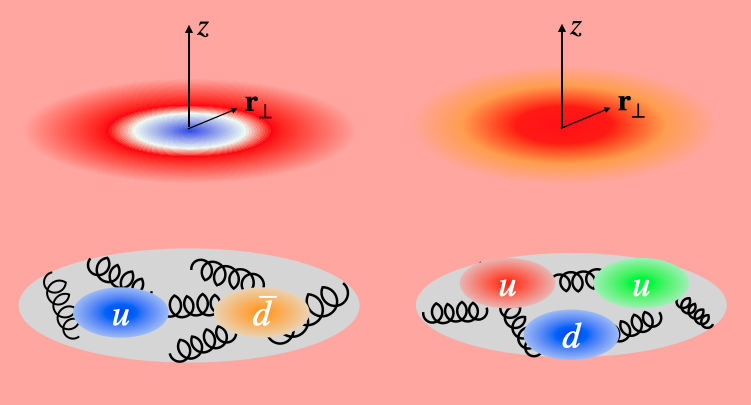Visualization of mass distribution within hadrons
Nuclear theorists reveal mass distribution within the pion and the proton from first principle numerical calculations.

The Science
The hadron mass can be obtained through the calculation of the trace of the energy-momentum tensor (EMT) which includes two terms: the trace anomaly and the sigma term. The trace anomaly due to conformal symmetry breaking is also believed to be an important ingredient for hadron confinement. The calculations show the mass distributions from the trace anomaly term for the nucleon and pion. For the pion, the mass distribution is similar to the charge distribution of the neutron. For the nucleon, the mass distribution is similar to the proton’s charge distribution.
The Impact
Understanding the origin of the nucleon mass is one of the major scientific goals of the Electron-Ion Collider (EIC). Scientists also want to understand how the mass from quarks and gluons is distributed in the hadrons. The calculations demonstrate that such distributions can be obtained numerically based on first principles calculation. Calculations resulting from this new approach will also aid in interpreting data from nuclear physics experiments.
Summary
Experiments exploring the origin of the nucleon mass are planned for the future Electron-Ion Collider at Brookhaven National Laboratory. In these experiments, electron-proton scattering can produce heavy quarkonium states, which are sensitive to the gluonic structure of the proton. The scatterings give scientists access to how the mass of quarks and gluons are distributed within the proton. This is like how Watson and Crick used X-ray diffraction to obtain the famous double-helix structure of DNA. The theoretical calculations predict the mass distribution of hadrons based on the Standard Model and guide future experiments. The results show key features of mass distributions within the pion and the nucleon and imply that the structure especially in the pion facilitates the correlation between conformal symmetry breaking and chiral symmetry breaking in the Standard Model.
Contact
Keh-Fei Liu
University of Kentucky
liu@g.uky.edu
Publications
- Bigeng Wang, Fangcheng He, Gen Wang, Terrence Draper, Jian Liang, Keh-Fei Liu, Yi-Bo Yang “Trace anomaly form factors from lattice QCD”, arXiv:2401.05496,
- Keh-Fei Liu “Hadrons, superconductor vortices, and cosmological constant”, Phys.Lett.B 849 (2024) 138418.

